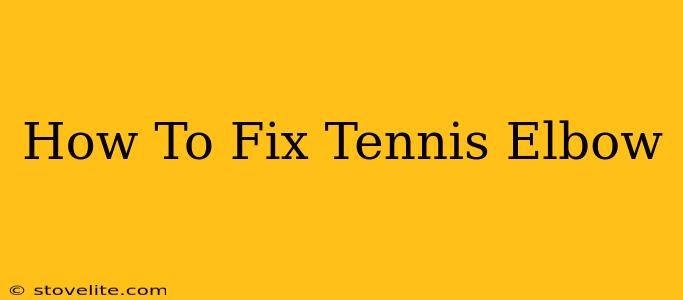Tennis elbow, or lateral epicondylitis, is a painful condition affecting the outer side of the elbow. It's characterized by pain that radiates down the forearm, often worsened by gripping objects or making a fist. While it's commonly associated with tennis players, anyone who repeatedly uses their forearm muscles can develop it. This comprehensive guide will explore effective ways to fix tennis elbow, focusing on both conservative and more interventional treatments.
Understanding the Root Cause of Tennis Elbow
Before diving into treatment, it's crucial to understand what causes tennis elbow. The condition stems from overuse and repetitive strain of the muscles and tendons that attach to the outside of the elbow, specifically the extensor carpi radialis brevis tendon. Activities involving repetitive gripping, twisting, or lifting can all contribute to the development of tennis elbow.
Common Causes Include:
- Repetitive hand movements: This is the most common cause, affecting individuals in various professions, including carpenters, painters, and musicians.
- Improper sports technique: In tennis, poor technique can put excessive strain on the elbow.
- Sudden forceful movements: A single, forceful movement can also trigger the onset of tennis elbow.
- Underlying medical conditions: In rare cases, underlying conditions like arthritis can exacerbate symptoms.
Effective Ways to Fix Tennis Elbow
Fortunately, most cases of tennis elbow respond well to conservative treatment. Here's a breakdown of effective methods:
1. Rest and Modification of Activities:
This is paramount. Avoid activities that aggravate your pain. This might mean temporarily modifying your work tasks or taking a break from sports. Allowing the tendons to heal is the foundation of recovery.
2. Ice and Elevation:
Applying ice packs to the affected area for 15-20 minutes several times a day can reduce inflammation and pain. Elevating your arm above your heart can also help minimize swelling.
3. Over-the-Counter Pain Relief:
Non-steroidal anti-inflammatory drugs (NSAIDs) like ibuprofen or naproxen can help manage pain and inflammation. Always follow the dosage instructions on the packaging.
4. Physical Therapy:
A physical therapist can design a personalized exercise program to strengthen the muscles around your elbow, improve flexibility, and reduce pain. This often involves a combination of:
- Stretches: Targeting the forearm muscles and wrist extensors.
- Strengthening exercises: Gradually building strength in the weakened muscles.
- Eccentric exercises: These focus on the lengthening phase of a muscle contraction, proving highly effective for tennis elbow recovery.
5. Bracing and Splinting:
A tennis elbow brace or splint can help support the elbow joint and reduce strain on the affected tendons. This can be particularly helpful during activities that aggravate the pain.
6. Corticosteroid Injections:
In some cases, a doctor may recommend a corticosteroid injection to reduce inflammation. This is usually a temporary measure and isn't a long-term solution.
7. Extracorporeal Shock Wave Therapy (ESWT):
ESWT uses sound waves to stimulate healing in the damaged tendons. This treatment option is becoming increasingly popular for tennis elbow.
8. Surgery:
Surgery is rarely needed for tennis elbow. It is typically reserved for cases that haven't responded to other treatments after a prolonged period.
Preventing Tennis Elbow Recurrence
Once your tennis elbow has healed, it's crucial to take steps to prevent recurrence. This includes:
- Maintaining good posture: Proper posture helps reduce strain on your muscles and joints.
- Using ergonomic tools: Using tools designed to minimize strain on your hands and arms.
- Regular stretching: Incorporating regular stretching exercises into your routine.
- Strengthening exercises: Continuing a regular strengthening program to maintain muscle strength.
- Modifying activities: Adjusting your work or sports technique to reduce strain on your elbow.
When to See a Doctor
If your tennis elbow pain is severe, persistent, or doesn't improve with home treatment, it's crucial to seek professional medical advice. A doctor can properly diagnose the condition and recommend appropriate treatment. Don't hesitate to consult a medical professional for any concerns. Early intervention can significantly improve your chances of a full recovery. Your health is your priority.

